Related Research Articles

Bayezid II was the sultan of the Ottoman Empire from 1481 to 1512. During his reign,Bayezid consolidated the Ottoman Empire,thwarted a pro-Safavid rebellion and finally abdicated his throne to his son,Selim I. Bayezid evacuated Sephardi Jews from Spain following the fall of the Nasrid Kingdom of Granada and the proclamation of the Alhambra Decree and resettled them throughout Ottoman lands,especially in Salonica.

Mehmed II,commonly known as Mehmed the Conqueror,was twice the sultan of the Ottoman Empire from August 1444 to September 1446 and then later from February 1451 to May 1481.
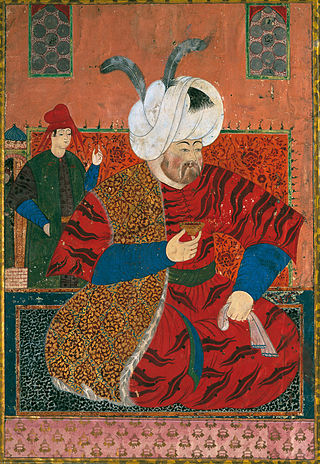
Selim II,also known as Selim the Blond or Selim the Drunkard,was the sultan of the Ottoman Empire from 1566 until his death in 1574. He was a son of Suleiman the Magnificent and his wife Hurrem Sultan. Selim had been an unlikely candidate for the throne until his brother Mehmed died of smallpox,his half-brother Mustafa was strangled to death by the order of his father and his brother Bayezid was killed on the order of his father after a rebellion against him and Selim.
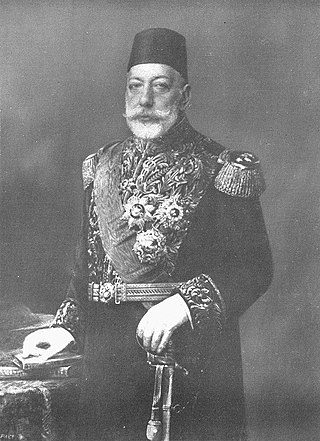
Mehmed V Reşâd was the penultimate sultan of the Ottoman Empire from 1909 to 1918. Mehmed V reigned as a constitutional monarch,interfering little when it came to government affairs,though the constitution was held with little regard by his ministries. The first half of his reign was marked by contentious politicking between factions of the Young Turks,and the second half by war and domination of the Committee of Union and Progress and the Three Pashas.
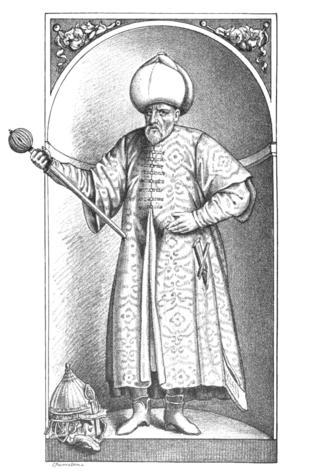
Sokollu Mehmed Pasha was an Ottoman statesman of Serbian origin most notable for being the Grand Vizier of the Ottoman Empire. Born in Ottoman Herzegovina into an Orthodox Christian family,Mehmed was recruited as a young boy as part of so called "blood tax" to serve as a janissary to the Ottoman devşirme system of recruiting Christian boys to be raised as officers or administrators for the state. He rose through the ranks of the Ottoman imperial system,eventually holding positions as commander of the imperial guard (1543–1546),High Admiral of the Fleet (1546–1551),Governor-General of Rumelia (1551–1555),Third Vizier (1555–1561),Second Vizier (1561–1565),and as Grand Vizier under three sultans:Suleiman the Magnificent,Selim II,and Murad III. He was assassinated in 1579,ending his near 15-years of service to several Sultans,as sole legal representative in the administration of state affairs.
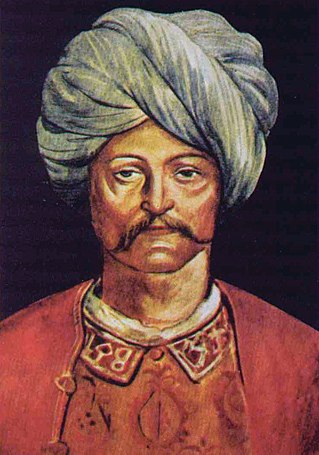
Cem Sultan or Sultan Cem or Şehzade Cem,was a claimant to the Ottoman throne in the 15th century.

The Karamanids,also known as the Emirate of Karaman and Beylik of Karaman,was one of the Anatolian beyliks,centered in South-Central Anatolia around the present-day Karaman Province. From the mid 14th century until its fall in 1487,the Karamanid dynasty was one of the most powerful beyliks in Anatolia.

Hüma Hatun was a concubine of Ottoman Sultan Murad II and the mother of Mehmed II.

Emine Gülbahar Mükrime Hatun was consort of Sultan Mehmed II,and mother of Sultan Bayezid II.

Mesih Pasha or Misac Pasha was an Ottoman statesman of Byzantine Greek origin,being a nephew of the last Roman emperor,Constantine XI Palaiologos. He served as Kapudan Pasha of the Ottoman Navy and was Grand Vizier of the Ottoman Empire in 1501.

Piri Mehmed Pasha was an Ottoman statesman,and grand vizier of the Ottoman Empire from 1518 to 1523.
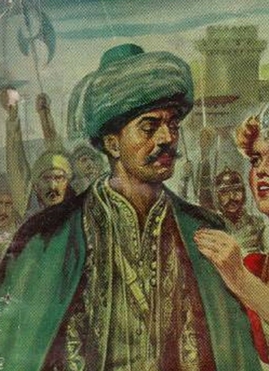
Gazi Hüseyin Pasha,also known as Deli Hüseyin Pasha or SarıHüseyin Pasha or Baltaoğlu Hüseyin Pasha,was an Ottoman military officer and statesman. He was governor of Egypt (1635–1637),Kapudan Pasha in the 1630s,and briefly Grand Vizier in 1656.
Ishak Pasha was an Ottoman general,statesman,and later Grand Vizier of Albanian or Greek origins.
KemankeşKara Mustafa Pasha was an Ottoman Albanian military officer and statesman who served as Kapudan Pasha and Grand Vizier of the Ottoman Empire.
Tayyar Mehmed Pasha was an Albanian Ottoman grand vizier. His epithet Tayyar means "flying",referring to his speed in military operations.
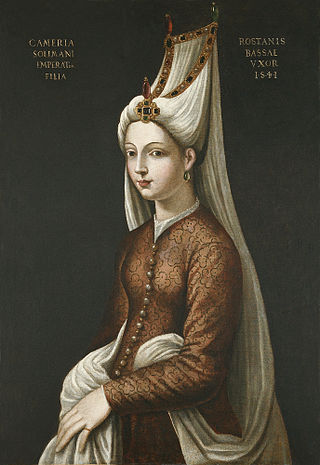
Mihrimah Sultan was an Ottoman princess,the daughter of Ottoman Sultan Süleyman the Magnificent and his wife,Hürrem Sultan. She was the most powerful imperial princess in Ottoman history according to historian Mustafa Selaniki who described her as the greatest and most respected princess and a prominent figure in the so-called Sultanate of Women. In Europe she was known as Sultana Cameria,while in Constantinople she was known as Büyük Sultan.
Abaza SiyavuşPasha was a short term grand vizier of the Ottoman Empire who held the post during one of the most chaotic periods of the empire.
Elmas Mehmed Pasha was an Ottoman statesman who served as grand vizier from 1695 to 1697. His epithet Elmas means "diamond" in Persian and refers to his fame as a handsome man.

SarıSüleyman Pasha was the grand vizier of the Ottoman Empire from 18 November 1685 to 18 September 1687. He was executed after the defeat of the Ottoman forces in the Second Battle of Mohács.

Ottoman wars in Asia refers to the wars involving the Ottoman Empire in Asia. Ottoman Empire was founded at the beginning of the 14th century. Its original settlement was in the northwest Anatolia where it was a small beylik (principality). Its main rival was Byzantine Empire. In 1350s Ottomans were able to cross the Dardanelles strait and eventually they conquered most of the Balkans. Although they mainly concentrated their expansions in Europe,they also expanded their territories in Asia,mainly in Fertile Crescent and Arabian Peninsula.
References
- ↑ Stavridis, Theoharis. "Karamani Mehmed Paşa". Encyclopaedia of Islam, THREE. Retrieved 25 May 2018.
- ↑ Ayhan Buz: Osmanlı Sadrazamları, Neden Yayınları, İstanbul, 2009 ISBN 978-975-254-278-5 p 25
- ↑ Biography of Karamanlı Mehmet (in Turkish)
- ↑ Mevlut Uluğtekin Yılmaz: Osmanlı’nın Arka Bahçesi, Ankara, 1998 [ page needed ]
- ↑ Nicolae Jorga: Geschiste des osmanischen (trans. by Nilüfer Epçeli), vol 2, p. 204 Yeditepe Yayınları, İstanbul, 2009, ISBN 975 6480 17 3
- ↑ Lord Kinross: The Ottoman Centuries (trans.Meral Gaspıralı), Altın Kitaplar, İstanbul, 2008 ISBN 978 975 21 0955 1 p 160
